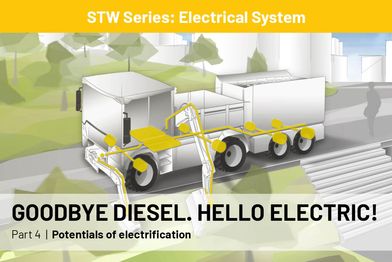Electrified vehicles are increasingly entering the market, be it due to stricter emission regulations, improved efficiency and controllability or a new green awareness among buyers. For OEMs or vehicle / machine operators, the obvious question is: What are the specific benefits of electrification of their vehicles? In our Electrical Systems series, we shed light on the subject and explain the new terminology.
With 35 years of experience in the digitalization, automation and electrification of mobile machines, we support our customers with customized workshops, the right concepts and suitable system architectures. But what exactly is this electrification? And how can I integrate it into my business model?
When hearing about electric vehicles and their advantages, the first things that come to mind are most likely lower CO2 emissions and the environmental bonus. However, the advantages of electric vehicles are many and varied, and in particular with utility vehicles and mobile machines, there are additional strengths depending on the type.
In comparison to a conventional vehicle, an electric vehicle has significantly fewer components and fewer parts that are subject to wear. Maintenance is therefore more cost-effective, also because exhaust emission testing and oil changes are no longer necessary. The components used in electric drives not only require less maintenance, but are also generally more durable.
Due to the more energy-efficient electric drive, the energy costs per kilometer driven are also lower than the costs incurred when operating the vehicle with a combustion engine.
Not only is the drive itself more energy efficient, but the electrical distribution also has a great efficiency advantage over e.g. hydrostatic drives. For mobile machines whose working drives are conventionally operated very inefficiently by diesel-hydraulics, considerable fuel savings could be achieved with diesel-electric operation (e.g. 20% for Pistenbully).
Electric vehicles do not produce CO2 and NOX emissions locally and can therefore also be used in the low emission zones of city centers. This is also interesting for utility vehicles such as road sweepers, wheel loaders or buses, as public tenders by local authorities sometimes only apply to the electrified vehicle versions.
But the electric vehicles also score points when it comes to reduced noise emissions. Significantly less noisy than the versions with combustion engines, they could be used during rest periods without hesitation. It would also be possible to carry out deliveries and collections by truck at night, thus extending production. Garbage collection vehicles could perform their work more quickly in the early morning hours with reduced traffic volumes.
Due to the higher efficiency of the electric drives, the heat development is also lower. In mining and tunneling in particular, where air conditioning and ventilation are very difficult, this – combined with emission-free operation –contributes to a more pleasant working climate. In any case, mining and tunneling will be subject to considerably stricter emission guidelines for NOX and diesel particulate emissions from 2021 onwards, which are almost impossible to implement without electrified machines.
The ability of electric drives to recuperate braking energy (described in Part 2 of this series) reduces the vehicle's energy consumption significantly (e.g. for ELIAS 15 %). In applications with frequent starting and stopping or uphill / downhill driving, even more energy can either be fed back into the HV battery or used to operate work functions (e.g. snow blower on a Pistenbully). In contrast to conventional vehicles, the braking process is carried out wear-free by the electric drives. For track vehicles, which steer by braking the chain(s) on the inner side of the bend, part of the energy can be recovered at each bend.
In contrast to the combustion engine, the electric motor reaches its maximum torque already at low speeds. Together with the overload capacity of electric drives, electrified vehicles can accelerate rapidly and also brake correspondingly quickly when operated as generators.
For customers who have plans for electrification, but are still unsure about the advantages and the extent, STW offers the right seminars. In the "System Design in Electrification Projects" training course, participants learn which components an electrified vehicle requires, how the overall system is structured and how design decisions could look like. In the subsequent system workshop, the possible benefits of an electrical version of the customer's machine are discussed, existing application scenarios are calculated and initial solution drafts are drawn up. The objective of the Training & Workshop is to make sure that the participants can start their electrification project well informed.
About STW
As an internationally active company with Headquarter in Kaufbeuren, we stand for the digitalization, automation and electrification of mobile machines for 35 years. With generic or customer-specific products, systems and solutions developed and manufactured at our headquarters in Germany, we support our customers with innovative technology on their way to making their machines the best in the world.
Supplemented by partner products and accompanied by our training, support and system teams, we help medium-sized companies and large OEMs to increase the performance and efficiency of their machines and increase safety. Through communication between machines, connectivity

![[Translate to Chinese:] [Translate to Chinese:]](/fileadmin/_processed_/f/4/csm_Logo_41f8d03cbf.jpg)